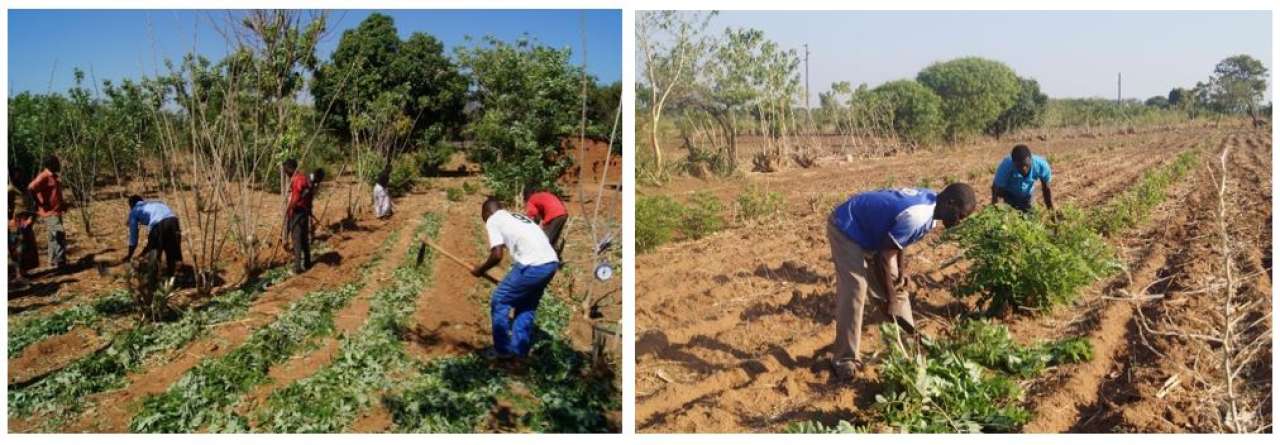Project update April 2021

Farmers incorporating Gliricidia leaves into the soil at the project sites, Vanganitaya village, Lumezi district, Zambia. Photos: Njoloma Joyce
Agroforestry impacts on soil fertility, crop yields and nutrition in Zambia
Gliricidia trees, planted together with other crops, showed a significant effect on the nutritional and functional properties in maize, soybean, and ground nuts trial plots. This is the results from the first-year trials in the research project that will last for two years.
In 2019, a joint research effort for documenting the effects of Gliricidia under conservation agriculture, in different farming systems in Zambia was established. According to FAO, conservation agriculture is a farming system that promotes minimum soil disturbance, maintenance of a permanent soil cover, and diversification of plant species.
Gliricidia (Gliricidia sepium) is a multi-purpose tree used for timber, firewood, medicinal purposes, charcoal, living fences, plantation shading, and not least soil improvement as a component of agroforestry. Agroforestry is a system in which trees or shrubs are grown around or among crops or pastureland. Gliricidia agroforestry tree has been adopted by many farmers in Africa particularly in Zambia and is being planted at a large scale, given its multi-benefits.
Analyse potential yield gains and communicate benefits to farmers
The project addresses the need for correlating available Gliricidia agroforestry technology with soil health to improve crop nutrition. Research results should help how small-scale farmers adopting conservation agriculture with agroforestry may be contributing to healthier, more-nutrient rich food crops. The emphasis of the two-year project is to do some in-depth analysis on the potential yield gains in maize-legume cropping systems using Gliricidia, and to build on the existing knowledge generated from previous research by the consortium partners and other sources.
Communication is a key priority in the project
“So far, our partner COMACO has reached out to more than 120,000 households in the project area to sensitise farmers on Gliricidia tree benefits and planting campaigns. To reach out they use the radio programme Farm Talk, that is aired three times per week”, explains Mehretab Tesfai, Research Scientist in NIBIO.
According to the Project Coordinator, Udaya Sekhar Nagothu, cooperation among the project partners was smooth during the Covid times, for instance COMACO extension workers assisted ICRAF and IITA in soils/crop sampling and measurements at harvesting time during the Covid -19 pandemic.
Possible measures (such as remote interactions) and necessary contingency plans have been prepared for cropping season 2020-2021.
Gliricidia pRoject News #1: January 2021
KEY MESSAGES
- Intercropping of Gliricidia-maize exhibited higher fat, ash, and protein contents when compared to monocropping,
- Intercropping of Gliricidia with Soybean measured higher fat, ash, and starch contents when compared to monocropping,
- Intercropping of Gliricidia with groundnuts showed higher total carbohydrate and starch, when compared to monocropping;
- Gliricidia intercropping with legumes showed lower tannins and phytic acids contents. This implies Gliricidia suppressed the formation of antinutrients, promoted better flour and good functional properties.
- The soils in Gliricidia-groundnuts intercropped fields showed higher population density of Aspergillus spp than fields without Gliricidia.
- Through the ‘Farm Talk platform’, COMACO has advertised healthy and nutritious food products such as yummy soy, peanut butter, natural honey, spices, poultry feed.
- Farmers should chop the leaves of Gliricidia sepium and incorporate them into the soil during land preparation and subsequent shoot cuttings in order to increase organic carbon contents of the soils thereby improve soil fertility.
